|
 Marasmius gelatinosipes Marasmius gelatinosipes
BiostatusPresent in region - Indigenous. Endemic
Images (click to enlarge)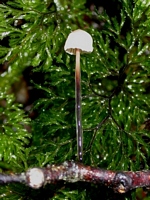
Caption: Characteristic glutinous stipe when fresh and wet. | 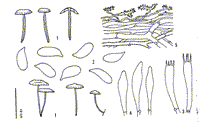
Caption: Fig. 21 (1-5). Marasmius gelatinosipes Desjardin & E. Horak (PDD, holotype).- 1.
Basidiomes.-2. Basidiospores.-3. Basidia.-4. Basidioles.-5. Pileipellis. | 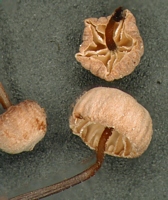
Owner: J.A. Cooper | 
Owner: J.A. Cooper | 
Caption: FUNNZ photo. Scale=5mm
Owner: J.A. Cooper | 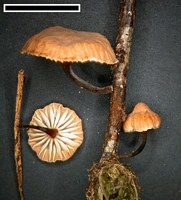
Caption: FUNNZ photo. Scale=5mm
Owner: J.A. Cooper | 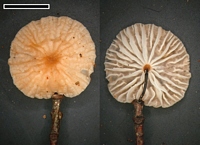
Caption: FUNNZ photo. Scale = 5mm
Owner: J.A. Cooper | 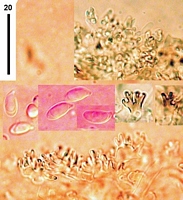
Caption: spores and diverticulate cap cells.
Owner: J.A. Cooper | 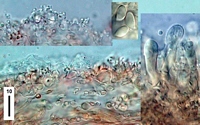
Owner: J.A. Cooper | 
Caption: diverticulate hyphae on cap, clamped encrusted cutis, and spores.
Owner: J.A. Cooper | 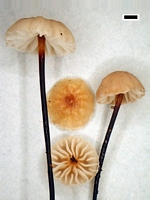
Caption: scale = 1mm
Owner: J.A. Cooper | 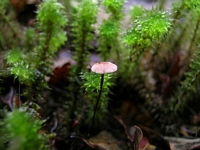
Owner: J.A. Cooper | 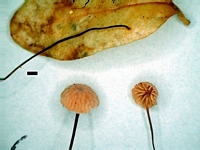
Caption: Scale = 1mm.
Owner: J.A. Cooper | 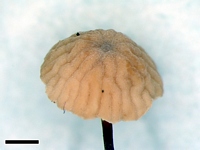
Caption: Scale = 1mm.
Owner: J.A. Cooper | 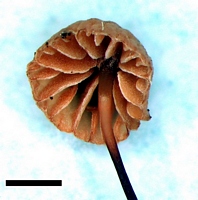
Caption: scale = 1mm. Too pink/brown
Owner: J.A. Cooper | 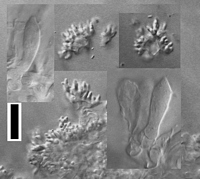
Caption: scale = 20um. Cheilocystidia and pileipellis cells
Owner: J.A. Cooper | 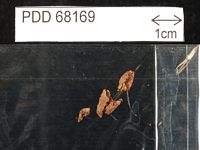
Caption: Dried type specimen
Owner: Herb PDD |
Article: Desjardin, D.E.; Horak, E. (1997). Marasmius and Gloiocephala in the South Pacific Region: Papua New Guinea, New Caledonia, and New Zealand taxa. Bibliotheca Mycologica 168: 152 p.
Description: Pi1eus 6-14 mm diam, hemispherical to convex when young, expanding with age to plano-convex with a flat or subdepressed disc; margin decurved, plicate; surface dull, dry, glabrous;
beige to pale reddish brown with a fuscous disc. Texture tough, membranaceous; context thin.-
Lamellae adnate, subdistant (11-13) with 2-series of lamellulae, often anastomosing, moderately
broad (up to 2 mm), beige; edges even, concolorous.- Stipe12-25 x 0.4-0.7 mm, central, equal or
gradually tapering towards the base, often twisted, wiry, glabrous when dry, in wet condition
covered with a thick, hyaline, gelatinous coat, insititious; white to beige at the apex, black elsewhere; rhizomorphs absent.- Odor and taste
not distinctive.
Basidiospores 6-8 x 3-3.5 µm, narrowly ellipsoid, smooth, thin-walled, hyaline, inamyloid.- Basidia
25-32 x 5-6 µm, cylindrical to subclavate, 4-spored, clamped.- Basidio1es 25-35 x 5-6 µm, fusoid,
thin-walled, hyaline.- Cheilocystidia absent.- Pleurocystidia absent.Pileipellis a Rameales-structure
with suberect to erect, diverticulate terminal cells, 10-25 x 4-10 µm , irregularly cylindrical, often
lobed, hyaline; diverticula 2-3 x 0.5-1.0 µm , irregularly cylindrical, hyaline; subcutis composed of
interwoven, cylindrical hyphae with brown incrusting pigment.- Pileal and lamellar t rama tissues
inamyloid.-Stipe tissues monomitic; cortical hyphae roughened, thick-walled, gelatinous, dark
brown, dextrinoid; medullary hyphae weakly hyaline, dextrinoid.- Cau1ocystidia absent. - Clamp
connections present.
Habitat: Habit, habitat and distribution.- Solitary or cespitose on rotten bark and leaves of Nothofagus
menziesii (Fagaceae). New Zealand.
Notes: As the epithet implies, the most unusual feature of M. gelatinosipes is a strongly gelatinous stipe
surface when wet and corresponding gelatinous stipe cortical hyphae. The absence of cheilocystidia
is also unusual although not unique to this species. Overlooking these two taxonomically important
features, M. gelatinosipes is similar to M. pilgerodendri Singer, another species that sporulates on
leaves of Nothofagus. Marasmius pilgerodendri, described from Argentina, differs in forming a
paler pileus, non-gelatinous stipe, and forms diverticulate cheilocystidia.
|